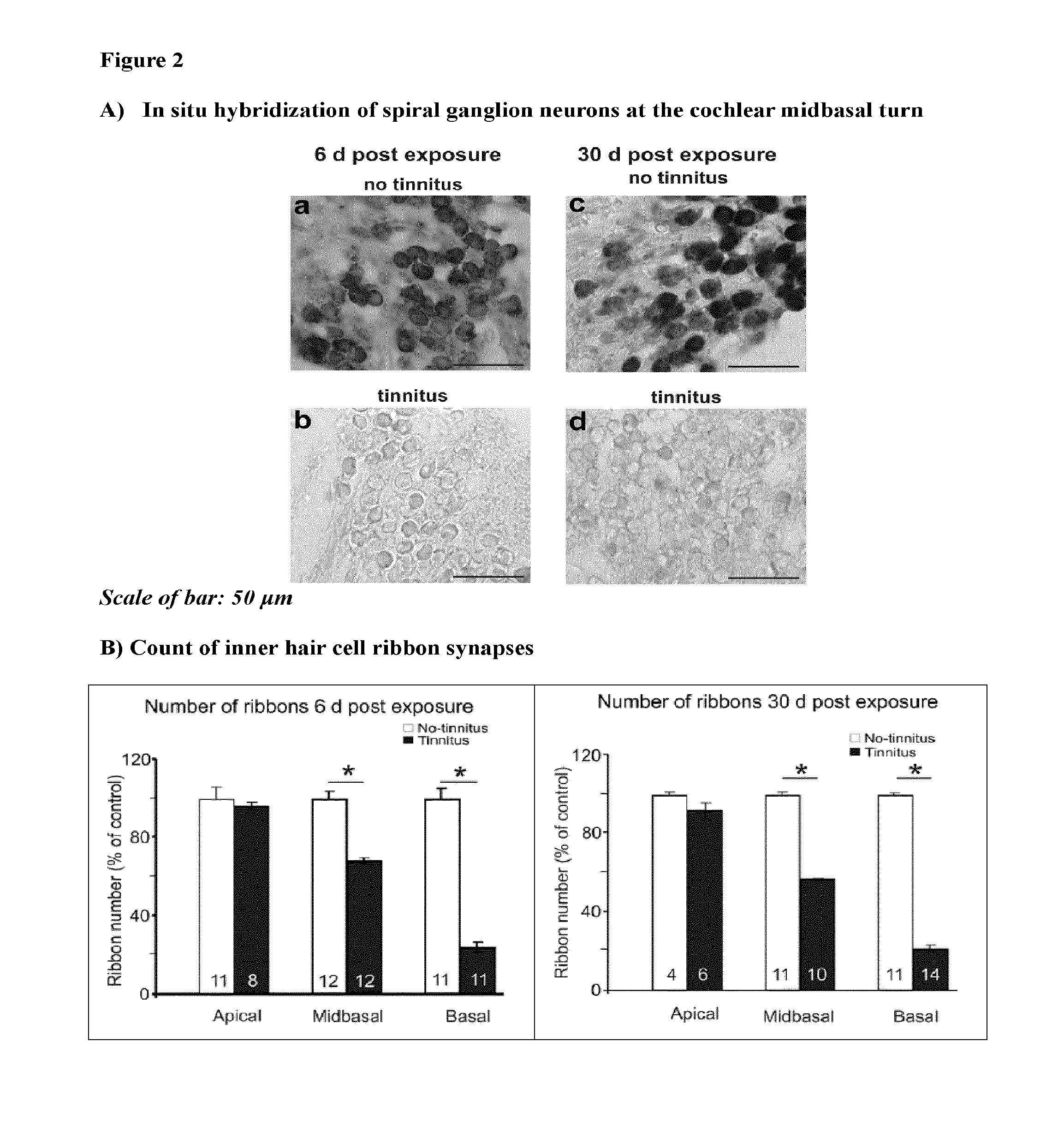Treatment of tinnitus through modulation of chloride co-transporter nkcc1 in the auditory system
a technology of chloride cotransporter and auditory system, which is applied in the direction of biochemistry apparatus and processes, material testing goods, compound screening, etc., can solve the problems of affecting the ability to sleep, relax, irritation, nervousness, despair, frustration, depression, etc., and the treatment of tinnitus remains a major unmet medical need
- Summary
- Abstract
- Description
- Claims
- Application Information
AI Technical Summary
Benefits of technology
Problems solved by technology
Method used
Image
Examples
example 1
[0144]Objective
[0145]The loop diuretic furosemide has been proposed as a (reversible) treatment of tinnitus. It has been hypothesized that it attenuates the firing of the auditory nerve by reducing the endocochlear potential (Risey et al., 1995). Yet, concurrently tinnitus is also known as a side effect of furosemide. The inventors sought to elucidate whether and, if yes, how the expression of chloride co-transporters in the cochlea changed following an insult to the cochlea susceptible of inducing tinnitus in order to identify starting points for the development of a novel pharmacotherapy for tinnitus.
[0146]Materials and Methods
[0147]13 anaesthetized adult female Wistar rats were exposed for 2 hours intra-aurally to a continuous 10 kHz tone at an intensity of 120 dB SPL in a sound attenuation booth. This exposure is susceptible of inducing tinnitus in rats (e.g. Tan et al., 2007). The acoustic stimulus was calibrated at the head level of the animal. Four anaesthetized control anima...
example 2
[0152]Objective
[0153]The aim of the 2nd experiment was to assess whether down-regulation of KCC2 observed in the first experiment was related to the pathophysiology of hearing loss or to that of tinnitus, or to both. This down-regulation could suggest that tinnitus induction by furosemide may be related to its known effect on KCC2, rather than through its attenuation of the endocochlear potential, as commonly suspected (e.g. Risey et al., 1995). For this purpose, a behavioural model as described by Rüttiger et al., 2003 was used to discriminate between animals with and without tinnitus.
[0154]Materials and Methods
[0155]36 adult female Wistar rats were trained in a conditioning chamber to actively access a liquid feeder whenever a constant sound was present. During silence, no reward was given. The conditioning was completed when animals performed more accesses to the reward feeder during periods of sound than during periods of silence.
[0156]On Day 0 conditioned rats were anaesthetize...
example 3
[0161]Objective
[0162]The aim of the third experiment was to assess whether pharmacological modulation of intracellular chloride levels in the cochlea following tinnitus-inducing noise trauma can suppress tinnitus. Since bumetanide has a much higher affinity for NKCC1 than tor KCC2 (Payne et al., 2003), its administration should—in view of the previous findings of the present invention—allow for reducing intracellular Cl− levels as the inhibitory effect on NKCC1 would dominate any—undesired—inhibitory effect an KCC2.
[0163]Materials and Methods
[0164]20 adult female Wistar rats were anaesthetized as described above for the previous experiments. First, auditory brainstem response (ABR) measurements were performed. As in Experiment 2, they were then exposed in a sound attenuation booth for 1.5 hours to a continuous 10 kHz tone at an intensity of 120 dB SPL (Group A; n=10) or sham exposed in the same seeing (Group B; n=10).
[0165]Animals were treated bilaterally right after noise trauma wi...
PUM
| Property | Measurement | Unit |
|---|---|---|
| time | aaaaa | aaaaa |
| pH | aaaaa | aaaaa |
| thickness | aaaaa | aaaaa |
Abstract
Description
Claims
Application Information
 Login to View More
Login to View More - R&D
- Intellectual Property
- Life Sciences
- Materials
- Tech Scout
- Unparalleled Data Quality
- Higher Quality Content
- 60% Fewer Hallucinations
Browse by: Latest US Patents, China's latest patents, Technical Efficacy Thesaurus, Application Domain, Technology Topic, Popular Technical Reports.
© 2025 PatSnap. All rights reserved.Legal|Privacy policy|Modern Slavery Act Transparency Statement|Sitemap|About US| Contact US: help@patsnap.com



